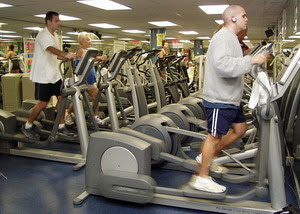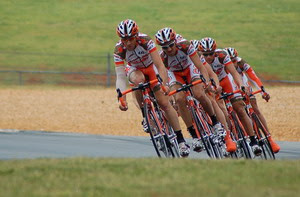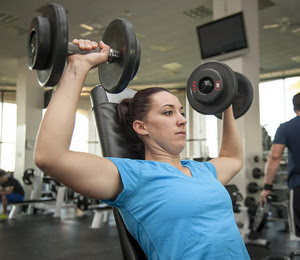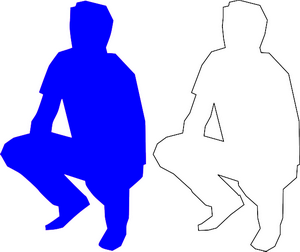
One of the favorite engagements this time of year is a renewed commitment to improving health through physical activity. While this is a noble effort, it rarely works. Generally within two months the daily visits to the gym have dwindled down to once a week as the reality of our busy life shows us why we weren’t going to the gym regularly before we made our New Year’s resolutions. Our lives are crazy busy, even when we are retired. I am always amazed at how busy my retired patients are.
The idea of going to a gym to work out is a really new idea for humans. It actually sprung from the occupation of Germany by Napoleon in the early 1800’s. As a way to push back and build a sense of German pride, a young Prussian officer began teaching gymnastics in an open air gym or Turner clubs to build physical and moral powers. In reality these were political clubs designed to reunite the German people against the French rule. Eventually these clubs were found out and banned and their founder, Friedrich Jahn, was imprisoned. Many of his followers emigrated to the US and ended up supporting Abraham Lincoln for president and

subsequently joining the Union Army. They spread their Turner physical culture methods to the army and this began the physical culture movement in the US. So going to the gym was really about tossing Napoleon out of Germany.
When you put going to the gym into its original context, creating a form of exercise that was separate from daily life made sense. But throughout human history, physical exercise has always been simply a part of everyday life, not a special separate event. The Turner movement fit the times as the industrial revolution suddenly created a workforce that was now stuck indoors in largely sedentary jobs. This is very unnatural for humans. Outdoor exercise fit the needs of the times to counter the degenerative forces afflicting the new workforce. But the political and social drive to belong to this type of special club has been lost. It is time to reintegrate physical exercise into the natural flow of everyday life.
How can we do this?

A ton of research has been done on exercise. The results that have been uncovered point us to the way to bring exercise back into daily life. For a long time the obsession was on cardiovascular fitness and the use of many hours of aerobic training as the way to achieve peak physical fitness. This perspective did not turn out well. Many of the guru’s of cardio fitness died at early ages from hardening of the arteries – the exact opposite of what was supposed to happen. This revelation parallels the bad advice about diet that was popular at that time – low fat high grain diets. People did not realize back then that oxygen is a very temperamental nutrient. Too little oxygen and you die, but too much and you rust. Hardening of the arteries is a type of rust in the body. When we hear about the dangers of free radicals in the body, what they are really talking about is molecules that carry excess oxygen around that damages tissues through oxidation (rancidity). Put in a nutshell, running long distances is a bad idea. Anything that makes you breath heavily for long periods of time is a bad idea. Humans are designed for bursts of activity – we are sprinters, not joggers. As

much as our culture still admires marathoners and Tour de France cyclists, they are terrible models for improving our health. Understand, being an athlete is a different thing from being healthy. Be an athlete because you love athletics, not because you think it is the way to get healthy.
Modern exercise physiology has shown us that real fitness is about short bursts of activity in both speed and strength. In modern times that looks like interval training and weight lifting. This is what I recommend to my gym rat patients. No jogging for an hour on the treadmill, no three sets of ten reps on twelve different weight machines. A thorough workout should only take 45 minutes. But this is not what I advocate for the average person, simply because it does not happen. It is a pretty goal, but it does not last. It is too separate from our daily life to be really functional. We need workouts that only take 30 seconds. We need workouts that do not require special clothes or fancy shoes. We especially need workouts that require no special equipment and that can be done anywhere at any time. We need a whole new way of thinking about exercise. We need to interrupt our sedentary life with brief bursts of activity.

What I am suggesting is simple and very doable for everyone of every age. This is to build basic functionality into our joints and muscles. If you are after high level athletic performance, then a lot more work is necessary. But for the 95% of us that just want to be healthy and functional, relatively little is needed. A few years back it was found that basic cardiovascular fitness could be achieved with just 15 to 20 minutes of interval training three time a week. Interval training involves running or cycling as fast as you can for 30 seconds then slowing to a casual walk/cycle for two minutes, then repeating the burst of speed for another 30 seconds. Generally 5 cycles of bursts and slows are done and then you are finished for a couple days. When you add that up it really means moving fast for all of 7 ½ minutes a week. That is very doable. Then several years later it was discovered that it did not matter how many minutes there was between bursts of speed, you still got the same benefit. So that means you could go fast for 30 seconds once every 2 or 3 hours. More research years later then showed us that going fast was not really the relevant feature of the exercise, it was the level of exertion and how well we depleted the sugar stores in the muscle fibers. What does that mean? That means that we need

to look more towards weight lifting, and specifically weight lifting performed in a super slow manner. OK, now things are starting to sound more civilized. A quick sprint down the street several times a day was possible, but not likely to actually happen. Doing something very slowly for 30 seconds a few times a day is starting to sound realistic.
Lets add in the final piece – body weight exercise, otherwise known as movement. What if all you had to do to maintain fitness was to engage in slow motion movement that provided significant exertion for a few seconds several times a day? No gym memberships needed, no Lycra outfits, no $200 shoes, just you and nothing else.
Probably the easiest exercise that engages the largest muscle in your body is doing simple squats. Try that for 30 seconds. Just right now do squats for 30 seconds. We can engage these from a speed angle and do as many as we can in 30 seconds, or we can do super slow squats and take 10 seconds to go down and another 10 seconds to come up. With super slow squats do not stop at any point, but keep the movement going until you can’t do any more – literally your legs give out. I recommend super slow squats only one time per week, as the depth of workout they give you takes 4 to 5 days to recover from. For you seniors or any of you that have poor

balance, do these squats over a chair. Squat down till your butt just hits the chair and then come back up. Start small – just a few squats, then build up to 10 or 20.
Arm exercises are also great for stimulating fitness. Just move those arms around. Make big circles, side to side, front to back, up and down. Arm movement especially get your heart pumping. It’s interesting that considerable work has been done showing that simply using a grip strength trainer reduces high blood pressure significantly. A simple arm exercise is good old push ups. These can be done against a wall or dresser to make them more achievable. The goal is to find a position that will wear out your arms in 10 to 20 push ups. Here too you can do the super slow ones once a week.
The picture I am painting is that mini movements are all we need to keep some level of muscle tone and joint functionality up in our body. You don’t need to get all

dressed up and sweat to get into shape. You just need to get moving for brief bursts throughout the day. Can you handle a little effort for 30 seconds or so 5 times a day to improve your health? Just 2 ½ minutes a day may not seem like much, but it could well be the most important minutes of the day to improve your health.
